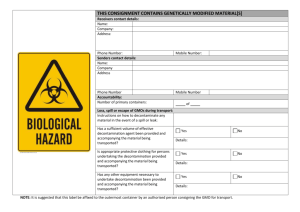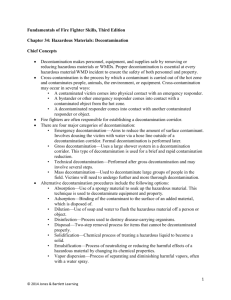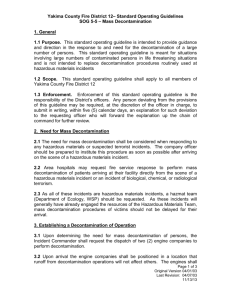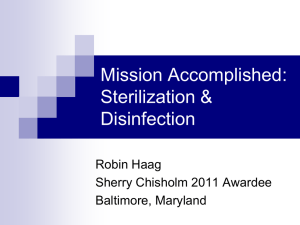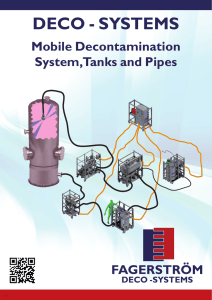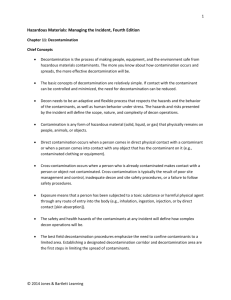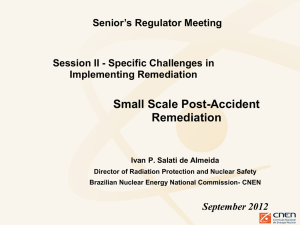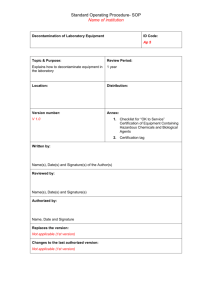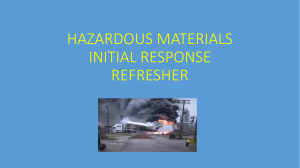Chapter 28
advertisement
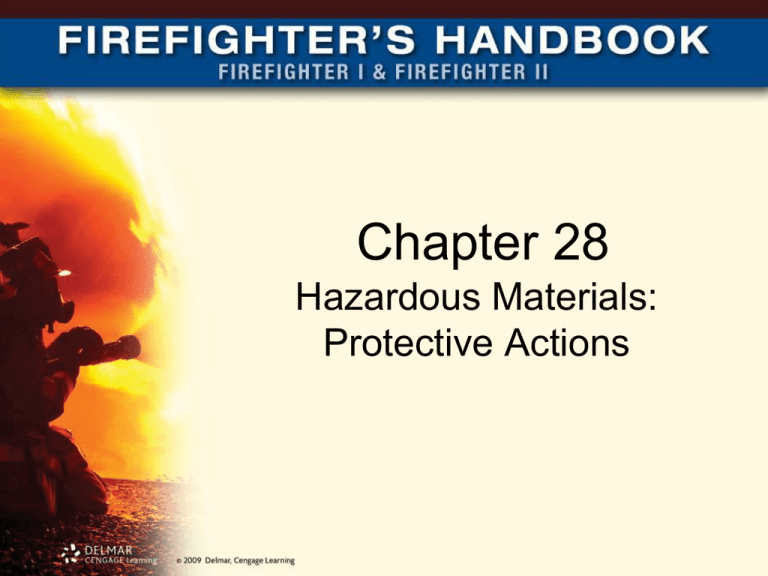
Chapter 28 Hazardous Materials: Protective Actions Introduction • There are general tactics when responding to a hazardous materials incident • Tactical considerations provided are for general situations • Firefighters beginning their training are unlikely to make evacuation decisions for several years 28.2 Hazardous Materials Management Processes • Several different management processes exist – 8-Step Process – GEDAPER Process – DECIDE Process • Cores of all systems are basically the same: protection of life, property, environment • Group of responders will fit into the ICS using one of these processes, or a combination 28.3 Hazardous Materials Management Systems 28.4 Isolation and Protection • One of the most important tasks • Methods – – – – Barrier tape Use of law enforcement Traffic barriers Use of emergency vehicles to block access • Control incident quickly 28.5 One of the first priorities should be to isolate the area so as to prevent other people from becoming involved with the incident. 28.6 Rescue • Rescue of victims from suspected hazard area can be extremely controversial • Local protocol and SOPs must be considered • Evaluate incident • Take into account response and notification time • Once out of the area, decontaminate • Procedures should be in place for rescuing trapped victims 28.7 Chemical Spills • Top 10 chemical spills – – – – – – – – – – Sulfuric acid Hydrochloric acid Chlorine Ammonia Sodium hydroxide Gasoline Propane Combustible liquids Flammable liquids Natural gas 28.8 Chemical Spills (cont’d.) • Response to an incident involving these chemicals should be no different than a response to a bedroom fire 28.9 Site Management • Management of hazardous materials incident can be difficult • When involved in a chemical release, many agencies can be involved • Liaison must be established between all agencies – Requires a minimum of two safety officers • Hazardous materials safety officer should be trained to Technician or Specialist level 28.10 Hazardous Materials Branch Positions 28.11 Establishment of Zones • Refers to areas that are established to identify various isolation points • Hot zone may be referred to as: – Exclusion zone – Isolation area – Hazard area • Warm zone: contamination reduction zone • Cold zone: support area 28.12 The establishment of zones is usually based on the types of hazards that may be present. For general chemical spills, the zones established are referred to as the hot, warm, and cold zones. 28.13 The best position for first responders is uphill and upwind from the release. 28.14 Evacuations and Sheltering in Place • Best way to determine evacuation or shelter is to conduct real-time air monitoring • If a decision is made to evacuate, a suitable location needs to be found – In most cases, sheltering in place is safer than evacuation • When sheltering, citizens should shut all windows and doors – Shut off air handling systems 28.15 Standard shapes for plumes or vapor clouds may form after a gas is released. The exact type varies with the topography and the buildings in the area. 28.16 Common Incidents • Overview of common incidents • Types of releases in each DOT hazard class • Recommendations provided are only suggestions • Local policies and procedures should be followed 28.17 Types of Releases • Type of release can be classified as – Breach in a container – Release within containment system • Several ways of looking at potential release of a chemical – Chemical is stressed – Container is stressed • Pressurized and nonpressurized containers can breach in several ways 28.18 Propane tank detonation. 28.19 Explosives • All persons must be removed from the area • Defensive operation should be established • Many other considerations come into play if fire is not directly impacting explosives • Examples of incidents involving explosives – Assisting a bomb squad – Shipment of explosives involved in an accident – Explosives brought by citizens to fire department 28.20 Gases • Incidents involving gases include – Flammable gases – Non-flammable gases • Many departments carry gas detection devices • Most commonly released flammable gases are natural gas and propane • When fighting propane fire, large quantity of water is applied quickly and continuously 28.21 Master streams are used to cool the hydrogen tanks on a tube trailer. (Courtesy of Maryland Department Environment ERD) Note the severe damage to this high pressure hydrogen tube trailer. It was involved in a traffic accident and caught fire. (Courtesy of Maryland Department Environment ERD) 28.22 Flammable and Combustible Liquids • Leading category for most common type of release • Considerable runoff when fighting this type of fire • Problems when using foam – Damaging to environment – Slippery 28.23 A diesel tank truck cab caught fire, impinging on the cargo tank. A quick and aggressive response by the Washington, DC, and Prince Georges County Fire Departments was able to knock down the fire before the contents were ignited. If the tank had become compromised, firefighting would have been very challenging because the tank truck was on a significant incline. Burning fuel would have traveled down the highway, possibly into storm drains. (Courtesy of Maryland Department Environment ERD) 28.24 Flammable Solids, Water Reactives, and Spontaneously Combustible Materials • Specific identity and emergency response information are crucial • Responders have experience with flammable solids • Water-reactive group defined in two ways • Materials that are spontaneously combustible are kept stable during transport 28.25 In this photo eight ounces of magnesium shavings were in a pool of burning diesel fuel. When the magnesium was heated, a slight water mist was sprayed over the fire. The white sparks are from the magnesium and the fireball is from the reaction as well. Relate the size of this violent reaction from a cup of magnesium to that of a truckload of magnesium. 28.26 Oxidizers and Organic Peroxides • Can have explosive characteristics • Best known oxidizer is ammonium nitrate • Liquefied oxygen (LOX) presents more hazards in addition to supporting combustion • Pool chemicals are another common oxidizer 28.27 A leak of liquid oxygen on asphalt can present a shocksensitivity problem in addition to the increased risk of a fire. 28.28 Poisons • Toxic in varying degrees but should be treated as poisonous by first responders • Most common incidents result from pesticides and agricultural chemicals • Commercial home fertilizers do not present much risk to responders unless in large quantities 28.29 Radioactive Materials • Incidents are rare • Radioactive materials commonly used in community – Smoke detectors – Ground imaging equipment – Medical community • Follow the adage: “Time, distance, and shielding” 28.30 Corrosives • Most common incidents – Sulfuric acid – Hydrochloric acid – Sodium hydroxide • Chemical protective clothing is required • Wash splashed material quickly • Chemical neutralization may be the best choice 28.31 The shipping papers did not indicate the presence of nitric acid. The brown vapor cloud is a result of a chemical reaction between bromine and red fuming nitric acid. When the hazardous materials team opened the back of the truck, they were greeted with these vapors. The team members in the photograph retreated when the vapors were released from the back of the truck and changed into chemical protective clothing. (Courtesy of Maryland Department Environment ERD) 28.32 Other Incidents • Impossible to outline each specific action that a first responder should take at a chemical release • Many toxic materials are odorless and colorless • Common incidents – – – – Sick buildings Odor complaints Gas leaks inside a building Explosions caused by gas grills 28.33 Decontamination • If first responder is expected to perform decontamination, then training is required • Decontamination is the physical removal of contaminants from: – People – Equipment – Environment 28.34 Types of Decontamination • Four general types of decontamination levels – – – – Emergency decontamination Technical decontamination Mass decontamination Fine decontamination • Process of decontamination is chemical specific 28.35 One of the simplest forms of emergency decon is the use of a hoseline. 28.36 Formal decontamination is used to remove any further contamination that may remain after gross decontamination. 28.37 Once additional resources arrive then the advanced plan for mass decon can be implemented. 28.38 An example of the decontamination vehicle completely set up. The use of the tent adds an additional layer of privacy. (Courtesy of Maryland Department Environment ERD) 28.39 Decontamination Process • Several variations to process • Basic decontamination steps – – – – – – – – Tool drop Gross decon Scrubbing and rinse PPE removal SCBA removal Clothing removal Body wash and dry off Medical evaluation, including rehydration 28.40 Methods of Decontamination • General methods apply to: – Humans – Equipment – Environment • Consult with hazardous materials team or a chemist prior to using any method on a human 28.41 Absorption • Spilled material picked up by absorbent material – – – – – – Ground-up newspaper Clay Kitty litter Sawdust Charcoal Poly fiber • Compatibility needs to be researched prior to use 28.42 Adsorption • Material to be picked up bonds to outside of adsorption medium – Activated carbon – Sand • Many chemical facilities have activated carbon stored 28.43 Chemical Degradation • Ability to degrade a chemical varies • Much like neutralization • Degrade a chemical – Another chemical is added or – Chemical is exposed to the elements 28.44 Dilution • Dependent on chemical structure of spilled material • With corrosive, large quantities of water are required 28.45 Disinfection • With humans, a 0.5 percent bleach and water solution can be used for some etiological contaminants • Contact time is needed for success • Plain water has proven effective for biological contaminants 28.46 Evaporization • Is allowing a chemical to evaporate changing its state of matter? • Solid or liquid left in the open will eventually change to vapor (depending on vapor pressure) • Chemical approaching boiling point will evaporate • Material does not disappear but merely changes its state of matter 28.47 Isolation and Disposal • One of the easiest forms of decontamination • Isolate the contaminant, collect it using protective clothing, and then dispose of contaminant • Follow appropriate regulations 28.48 Neutralization • Usually reserved for corrosive materials • Can reduce toxicity of a poisonous material • Consult with chemist prior to performing this type of activity 28.49 Sterilization • Two primary methods of sterilization – Combination of steam and high heat – Chemical sterilization • Steam and high heat useful for etiological contamination • Chlorine dioxide used to decontaminate buildings with anthrax contamination 28.50 Solidification • Depending on solidification agent used, it may alter the suspect agent • Some cases, solidification agent has no effect on agent – Will reduce hazard and enable sampling • Chemical compatibility must be confirmed 28.51 Vacuuming • Used for solids, such as dust or fibers • Use a vacuum with a HEPA filter • Special vacuums are made for picking up mercury – Prevent mercury vapors from entering the air 28.52 Washing • Done with soap and water • One of the more effective decontamination solutions • Soap and water merely removes contaminant • Use air monitors to test effectiveness of decontamination • Some response teams and emergency plans outline incident levels 28.53 Methods of Decontamination 28.54 Lessons Learned • Protective actions used for a variety of purposes • Management of a chemical-release is not an easy task • Determination for decontamination can also be a difficult decision • Choosing method of decontamination can be difficult • Provide isolation and prevent escalation 28.55
